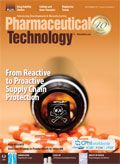A QbD-Based Approach to Drug Packaging and Delivery
When it comes to getting the best out of quality by design, timing is everything.
Ieromin/shutterstock.com

Over the past several years, the pharmaceutical industry has seen a steady shift toward increased patient centricity. The impact can be seen in nearly every aspect of the industry-from regulatory guidance, trial design, and drug delivery to new drugs proliferating the pipeline, such as biologics.
Biologics are used to treat chronic conditions, such as multiple sclerosis and other autoimmune diseases. Additionally, these therapies can help acute conditions, such as certain types of cancer, become manageable chronic conditions by targeting specific components of a disease in ways never thought possible before.
However, with this comes new considerations for biopharmaceutical companies and their manufacturing partners around drug delivery and risk mitigation. In this new era, the adoption of quality-by-design (QbD) principles in the development and manufacture of drug products is a way to put the patient first. This is driven and supported by regulatory guidance (e.g., International Council for Harmonization [ICH] 8, 9, and 10) driving increased focus on quality within the biopharmaceutical industry.
Innovative therapies drive new considerations
As biologics and biosimilars enter the global pharmaceutical market, they can and will present unique packaging and containment challenges. Biologics offer promising potential for patients through targeted treatments; however, they also bring new considerations for biopharmaceutical companies and their manufacturing partners around drug packaging and delivery and risk mitigation.
With most biologics in development taking injectable form, drug makers are increasingly exploring the use of prefillable syringe and self-injection systems for their administration. The potential for improved patient experience only further drives this approach: self-injection systems can give patients newfound freedom to self-manage their diseases outside of traditional healthcare settings, such as the doctor’s office or clinic.
The adoption of QbD principles helps to ensure that components are engineered with stringent and specialized needs in mind.
While they offer the potential for newfound freedom for patients, advanced biologics often have specialized needs around containment and delivery. Many are highly viscous, which may require larger containment systems and slow dosing of large volumes of the drug over time. Additionally, biologics can have sensitive chemical compositions that pose the potential for interaction with materials traditionally used for packaging and delivery systems.
Therefore, demands on packaging components are changing: it is essential to package these new biologics with high-quality components that can help protect the quality, safety, and efficacy of the product. The adoption of QbD principles in the design and manufacturing of packaging components for these therapies helps to ensure that components are engineered with these stringent and specialized needs in mind.
The role of QbD
The adoption of QbD principles delivers an improved, data-driven output, providing manufacturers with superior product and process understanding that minimizes risk, emphasizes patient-critical quality requirements, and supports drug product effectiveness in an industry where patient-centricity is paramount and quality must be top of mind from the very beginning.
QbD principles were designed to promote an understanding of the drug product and manufacturing process starting with product development. During the design and development process, a QbD-driven approach requires manufacturers to define desired product performance goals and identify critical quality attributes (CQAs). The product and process can then be designed to meet those attributes, potentially improving understanding of how material attributes and process parameters impact CQAs and enabling manufacturers to mitigate variability.
QbD has helped facilitate more expedient and efficient introduction of high-quality biologics to market because stakeholders are now armed with critical data that allows them to control potential risk factors. It also allows drug, packaging, and delivery manufacturers to continually monitor and adjust their manufacturing processes to ensure consistent quality throughout a drug product’s lifecycle.
The scientific, risk-mitigation based QbD approach is fast becoming an essential strategy for bringing high-quality biologics to market quickly and efficiently while identifying and controlling potential quality concerns. High-quality components designed using QbD principles and processes can help optimize the performance of drug delivery systems and protect sensitive drug products with exceptional cleanliness and barrier properties, while helping to ensure patient safety.
QbD in component design and considerations
One class of products in particular that is essential to understand and assess during the QbD process is prefillable syringe plungers. Plungers (also called pistons and stoppers) are important elements in injectable drug delivery because they serve as the primary seal for container/closure integrity-helping to maintain the purity of drugs during shelf life. Plungers are typically made from butyl rubber and can be coated with a fluoropolymer film to increase lubricity and serve as a barrier between the drug and the elastomer, reducing the potential for leachables.
There are new component offerings on the market designed to address the need for high-quality packaging solutions, including components designed using QbD principles to provide high reliability for breakloose and glide force, dimensional accuracy and consistency, subvisible and visible particulate control, and low parts per million (ppm) defect attributes.
Adhering to QbD principles in the design and manufacturing of drug packaging components ensures that critical product quality criteria are consistently met. Additionally, the knowledge gained throughout the QbD process is used to enable continuous improvement in manufacturing and design for future pharmaceutical products.
Conclusion: Early collaboration is the key to success
Now, more than ever, employing a QbD approach to component design and manufacturing keeps the needs of both patients and drug manufacturers at the forefront. This is especially important as many sensitive biologics are coming on the market as combination products--the compatibility of packaging components with injectable drugs and their delivery systems is being closely scrutinized.
To achieve the most benefits via QbD, though, timing is everything. Pharmaceutical companies and their packaging and delivery partners should build this level of quality monitoring and risk mitigation into the development and manufacturing process from the very beginning. By doing so, not only can high quality standards be met through commercialization, but patients using cutting-edge therapies globally have a better chance of doing so safely and effectively.
Article Details
Pharmaceutical Technology
Volume 40, Number 9
September 2017
Pages: 32–35
Citation
When referring to this article, please cite it as F. DeGrazio, “A QbD-Based Approach to Drug Packaging and Delivery," Pharmaceutical Technology 41 (9) 2017.
